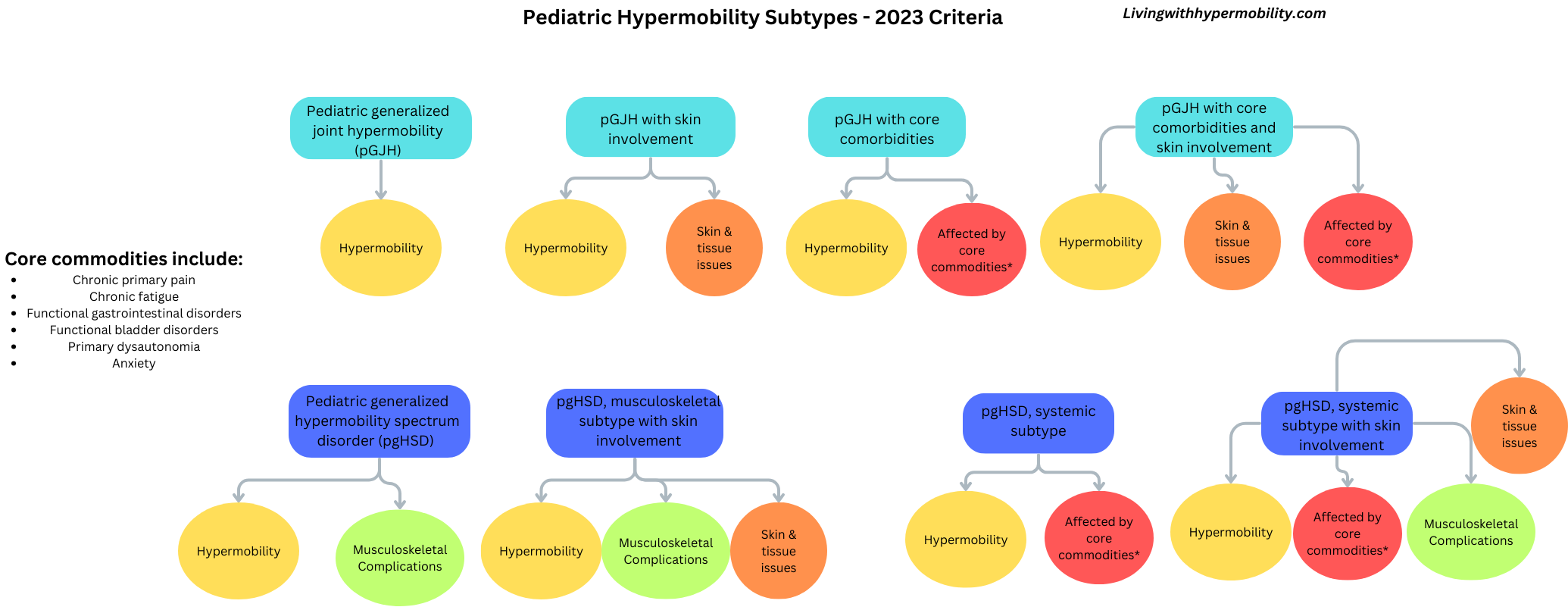Affiliate Disclosure: This post may contain affiliate links. This means we may earn a commission if you make a purchase through these links. This is at no extra cost to you. We only recommend products and services we truly believe in. Your support helps us keep the site running! Thank you.
A new diagnostic framework for childhood hypermobility has been published, which includes 8 new subtypes. The framework was developed by the Pediatric Working Group of the International Consortium on Ehlers-Danlos Syndromes (EDS) and Hypermobility Spectrum Disorders (HSD). It was published in the journal Pediatrics on May 12, 2023.
How to recognize hypermobility in children
The new framework is based on the following five key considerations:
- Is generalized joint hypermobility present?
- Are musculoskeletal complications present?
- Is the person affected by comorbidities?
- Is there skin and tissue involvement?
- Have other conditions that could cause the person’s symptoms been excluded?
What hypermobility subtypes can children have?
Children with generalized joint hypermobility will now be receive a diagnosis of one of the following eight categories:
- Pediatric generalized joint hypermobility (pGJH) – This category is for children who have generalized joint hypermobility but do not have any musculoskeletal complications, comorbidities, or skin and tissue involvement.
- pGJH with skin involvement – This category is for children who have generalized joint hypermobility and have skin involvement. Skin issues may include unusually soft skin, mild skin hyperextensibility, unexplained stretch marks, atrophic scarring, bilateral piezogenic papules of the heel, or recurrent hernia or hernia in more than one site.
- pGJH with core comorbidities – This category is for children who have generalized joint hypermobility and have one or more core comorbidities. Comorbidities include chronic primary pain, chronic fatigue, functional gastrointestinal disorders, functional bladder disorders, primary dysautonomia, or anxiety.
- pGJH with core comorbidities and skin involvement – This category is for children who have generalized joint hypermobility. They’ll also have one or more core comorbidities and skin involvement.
- Pediatric generalized hypermobility spectrum disorder (pgHSD) – musculoskeletal subtype: This category is for children who have generalized joint hypermobility and musculoskeletal complications. But they won’t have any comorbidities or skin and tissue involvement.
- pgHSD, musculoskeletal subtype with skin involvement – This category is for children who have generalized joint hypermobility, musculoskeletal complications, and skin involvement.
- pgHSD, systemic subtype – This category is for children who have generalized joint hypermobility and systemic complications, such as cardiovascular, respiratory, or endocrine problems.
- pgHSD, systemic subtype with skin involvement – This category is for children who have generalized joint hypermobility, systemic complications, and skin involvement.

What are the benefits of the new hypermobility diagnostic framework for children?
Ultimately, the new diagnostic framework is a significant step forward in the diagnosis and management of childhood hypermobility. We already know that hypermobility runs in families. But the new framework provides a more accurate and comprehensive way to assess children with joint hypermobility, and it will help to ensure that children receive the appropriate treatment and support.
What are the downsides of the new hypermobility diagnostic framework for children?
Unfortunately, there are a few downsides to the new hypermobility diagnostic framework for children including:
- The new framework is only for children aged 5 years and over.
- If a child’s symptoms change, they’ll need another assessment.
- Prepubescent children cannot be diagnosed with hypermobile Ehlers-Danlos syndrome (hEDS) under the new guidelines.
- Bruising is not listed as a skin issue in the new framework.
- Once a young person is biologically mature they should have an assessment using the 2017 hEDS criteria.
- There are 8 new hypermobility acronyms to get your head around!
Childhood hypermobility is common. Hopefully, the new framework will make it easier to diagnose hypermobility in children. Plus, it’s sure to help them get the treatment and support that they need.

